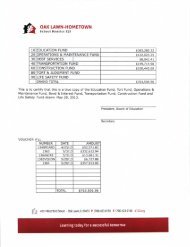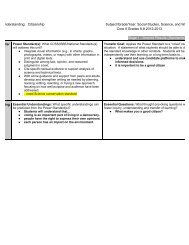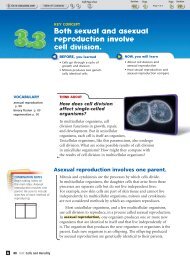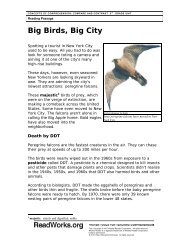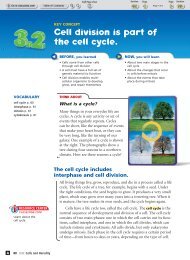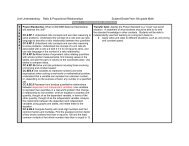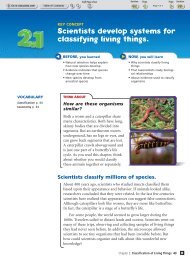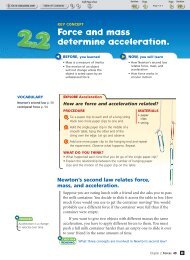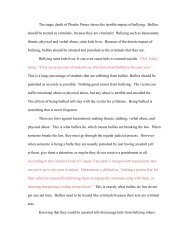The cell is the basic unit of living things. - Durant Road Middle School
The cell is the basic unit of living things. - Durant Road Middle School
The cell is the basic unit of living things. - Durant Road Middle School
You also want an ePaper? Increase the reach of your titles
YUMPU automatically turns print PDFs into web optimized ePapers that Google loves.
eading tip<br />
<strong>The</strong> word microscopic <strong>is</strong> an<br />
adjective made from <strong>the</strong><br />
noun microscope. Things<br />
that are microscopic are too<br />
small to see without <strong>the</strong> use<br />
<strong>of</strong> a microscope.<br />
<strong>The</strong> microscope led to <strong>the</strong> d<strong>is</strong>covery <strong>of</strong> <strong>cell</strong>s.<br />
Most <strong>cell</strong>s are microscopic, too small to see without <strong>the</strong> aid <strong>of</strong> a<br />
microscope. A microscope <strong>is</strong> an instrument which makes an object<br />
appear bigger than it <strong>is</strong>. It took <strong>the</strong> invention <strong>of</strong> th<strong>is</strong> relatively simple<br />
tool to lead to <strong>the</strong> d<strong>is</strong>covery <strong>of</strong> <strong>cell</strong>s. In <strong>the</strong> 1660s, Robert Hooke<br />
began using microscopes to look at all sorts <strong>of</strong> materials. Anton van<br />
Leeuwenhoek took up similar work in <strong>the</strong> 1670s. <strong>The</strong>y were among<br />
<strong>the</strong> first people to describe <strong>cell</strong>s.<br />
Robert Hooke gave <strong>the</strong> <strong>cell</strong> its<br />
name. While looking at a sample<br />
<strong>of</strong> cork, a layer <strong>of</strong> bark taken from<br />
an oak tree, he saw a group <strong>of</strong><br />
similarly shaped compartments<br />
that looked to him like tiny empty<br />
rooms, or <strong>cell</strong>s. You can see from<br />
h<strong>is</strong> drawing, shown at right, how<br />
well <strong>the</strong>se <strong>cell</strong>s fit Hooke’s description.<br />
Hooke used a microscope<br />
that magnified objects 30 times<br />
(30). In o<strong>the</strong>r words, objects<br />
appeared thirty times larger than<br />
<strong>the</strong>ir actual size.<br />
Hooke’s Drawing <strong>of</strong> Cells<br />
Robert Hooke publ<strong>is</strong>hed th<strong>is</strong> drawing<br />
<strong>of</strong> dead cork <strong>cell</strong>s in 1665. <strong>The</strong><br />
microscope he used, shown at left,<br />
has two lenses.<br />
<strong>The</strong> bark <strong>cell</strong>s Hooke saw were<br />
actually dead <strong>cell</strong>s, which <strong>is</strong> why <strong>the</strong>y appeared empty. Anton van<br />
Leeuwenhoek was one <strong>of</strong> <strong>the</strong> first people to describe <strong>living</strong> <strong>cell</strong>s.<br />
He looked at a drop <strong>of</strong> pond water under a microscope. Imagine h<strong>is</strong><br />
surpr<strong>is</strong>e when he saw that a drop <strong>of</strong> water was full <strong>of</strong> <strong>living</strong> <strong>things</strong>!<br />
Using lenses that could magnify an object almost 300, he observed<br />
tiny uni<strong>cell</strong>ular organ<strong>is</strong>ms like those shown on page 11.<br />
Check Your Reading<br />
How did <strong>the</strong> invention <strong>of</strong> <strong>the</strong> microscope change <strong>the</strong> study<br />
<strong>of</strong> biology?<br />
You can understand how powerful a microscope <strong>is</strong> if you think<br />
<strong>of</strong> how big a penny would be if it were increased in size 30 .It<br />
would be a little bigger than <strong>the</strong> tire <strong>of</strong> a ten-speed bicycle. Enlarged<br />
300 ,that penny would be so big that you would need a tractortrailer<br />
to move it. Magnify your best friend 30 (supposing a height<br />
<strong>of</strong> 1.5 meters, or almost 5 ft), and your friend would appear to be 45<br />
meters (147 ft) tall. That’s almost <strong>the</strong> height <strong>of</strong> Niagara Falls. Change<br />
<strong>the</strong> magnification to 300 , and your friend would appear to be 450<br />
meters (1470 ft) tall—taller than <strong>the</strong> Empire State Building.<br />
EA<br />
12 Unit: Cells and Heredity



